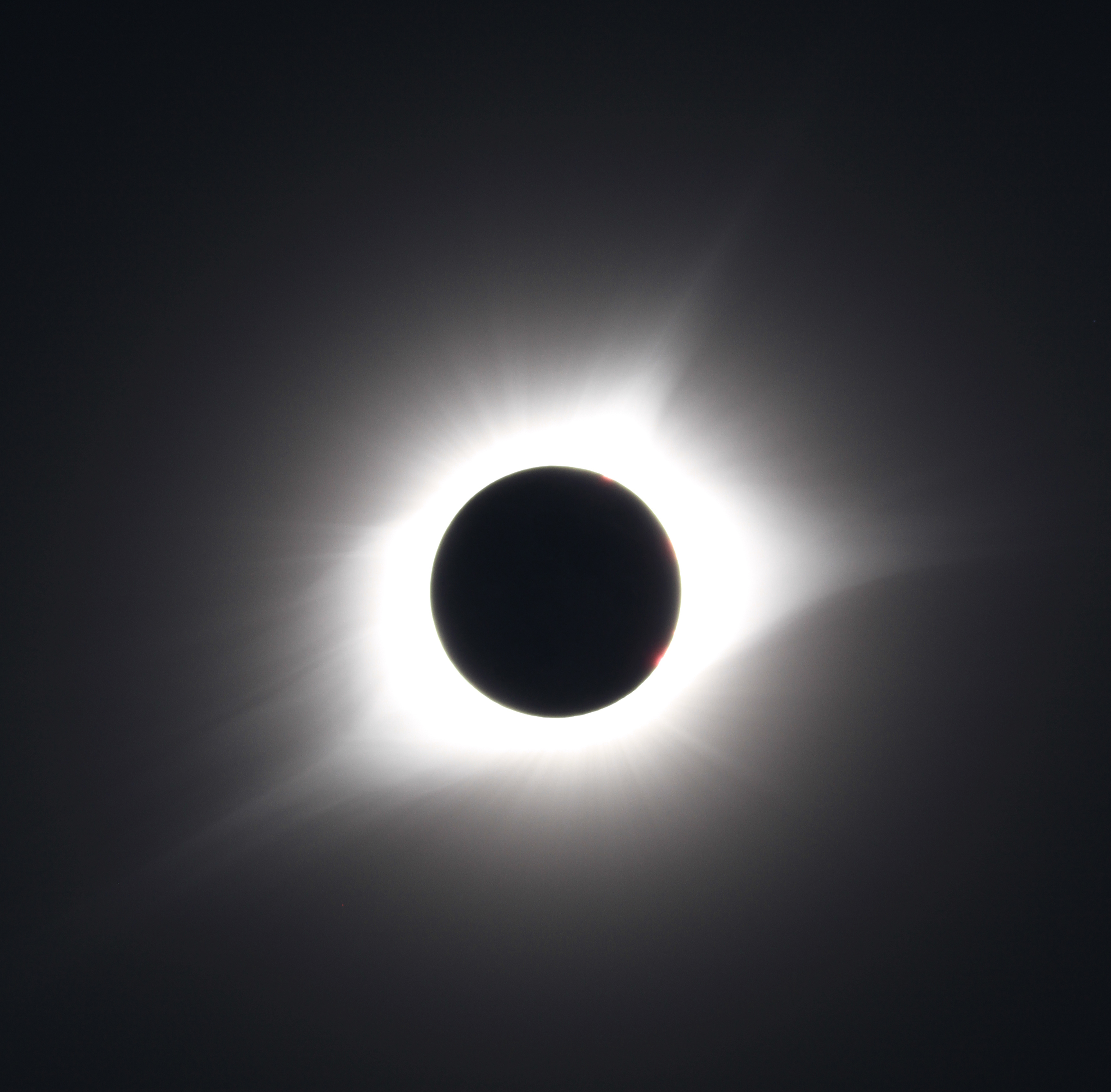
23 Aug TIO Wyoming: Eclipse or “The Bear Taking A Bite Out Of The Sun”
They say it’s the journey, not the destination, but in this very particular case, that old trope was eclipsed by the eclipse.
According to NASA’s website, throughout virtually every civilization for a millennia, solar eclipses were interpreted as portents of doom and gloom. Through the ages, recorded responses ran the gamut from human sacrifice to feelings of fear and bewilderment.
How then to explain our all time high?
The morning of August 21 was a Camelot moment. The special beauty of the eclipse accomplished what for many feels like an elusive goal: people from all walks of life, from all parts of the country and globe, coming together in wonder and awe.
The drive from Telluride to Riverton, WY alone would be worth the trip: over Dallas Divide, down the Uncompagre River to Grand Junction, over Douglas Pass into the far northwest of Colorado, through Flaming Gorge and across the high country in southwest Wyoming, northeast to Riverton at the edge of the Wind River Range.
The return to Telluride, however, was not as much fun, as many of the visitors to central Wyoming all dumped into the few highways connecting to the south, east and west. Not fun as in 4 hours to travel the first 30 miles, and occasional bottlenecks until we got past Rock Springs. But the magnificence of our eclipse experience made the inconvenience pale in contrast.
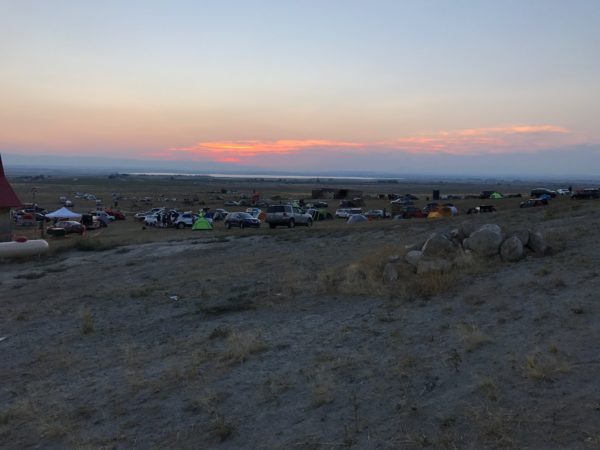
Blazing 7s Campground, dusk, image, Clint Viebrock.
I made our plans late and was aware that lodging was difficult to impossible, so had packed a tent and was prepared to sleep in the car. Sunday morning, just before we left, I gave it one more shot: Blazing rockets, Commander! Blazing 7s Ranch had car camping space available. I didn’t take the time to check it out, just hit the “Pay” button, and we hit the road.
I put the site into our nav system when we got close to Riverton and was pleasantly surprised to find that our destination was north-northwest of town. That put it even closer to the centerline of the zone of totality, eclipse hunters’ pot of gold! The campground was a bit rough, but our hosts were friendly, and the multitude gathered there seemed happy to put up with some shortage of amenities for the open space that spoke of perfect viewing of the phenomenon we had all come to witness.
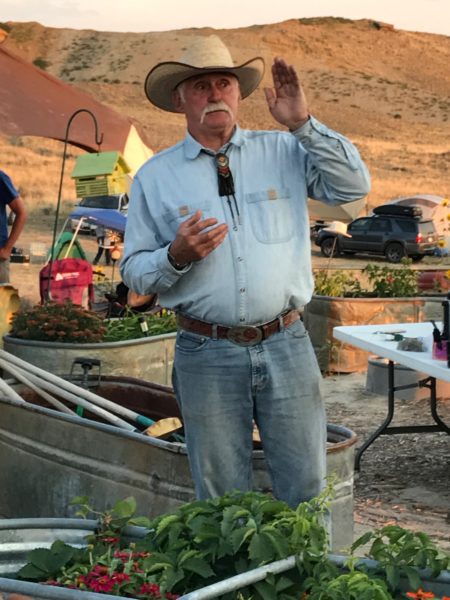
History lesson, Riverton, Clint Viebrock photo.
We had daylight to set up our simple camp, then found that the picnic style dinner (choice: veggie or full-fuel beans, potato salad and cole slaw) was still available. We hadn’t made a meal reservation, so that was a happy bonus. We took a short walk up the steep slope bordering the campground to check out the view, then returned to the fire pit to listen to a talk about the Riverton area and its history. We hadn’t talked to many of our fellow eclipse seekers, as everyone was involved in setting up housekeeping, readying equipment for tomorrow’s big event. We read with the remaining light, then to our tent early for the night.
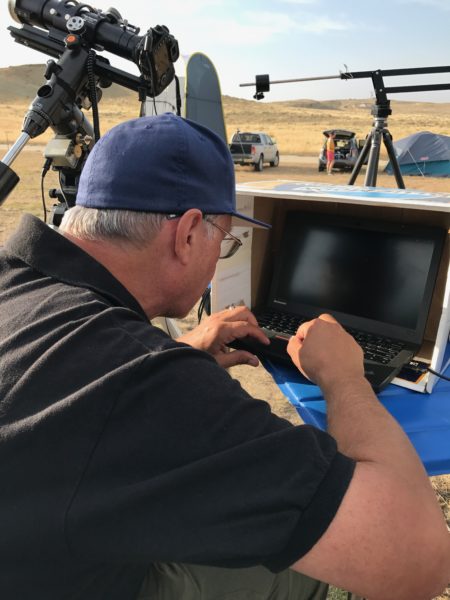
Andy, engrossed at his computer, image Clint Viebrock.
Monday morning was a different story: maybe because it had been a chilly night and people were happy to be up early and moving, but I think mostly because of the excitement about what lay ahead. The whole camp was bustling about, setting up telescopes and big binoculars with their dark lens covers, making connections between sophisticated cameras and computers, visiting with neighbors.
The energy flowing through our dusty campground was palpable. And those with eclipse experience seemed pleased to share their knowledge with those of us who were new to the game.
Our immediate neighbors included Andrew Macica, his wife, Christine, and sister Gerry from the Bay Area of California; Mark Mitchnik and his son Malachi from East Hampton, NY; a group of young, avowed eclipse chasers from Lausanne, Switzerland; a couple from Saskatoon. There were visitors quite literally from around the World, all drawn to this small Wyoming town that happened to be nearly on the centerline of this historic eclipse: it made landfall on the Oregon coast and traversed the entirety of the U.S., finally exiting on the Carolina coast.
There was some concern that early clouds might obscure the whole effect, and some thin clouds remained where we were just as the sun was nearing the time of first contact, 1019 MDT. Then an audible sigh of relief could be heard across the grounds as the skies cleared just as the “bear was taking a bite out of the sun” – the way one Native American tribe, the Porno people of Northern California, described the eclipse.
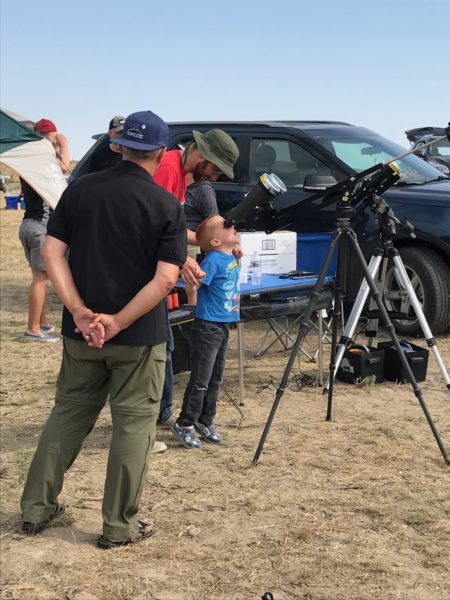
Boy sees Bear taking a bite out of the Sun, image, Clint Viebrock.
Andy spent much of the morning showing interested children and adults his camera/computer setup, as well as binocular views of the sun before and during the moon’s crossing. The beautiful photographs of the eclipse approaching and at totality shown below are sone of the many that came out of Andy’s DSLR camera/computer arangement.
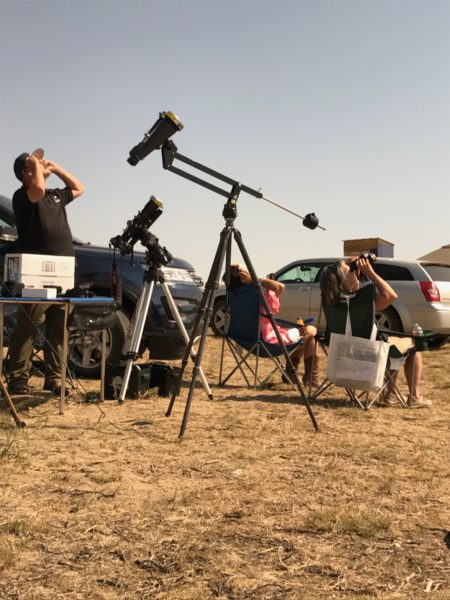
Watchers, image, Clint Viebrock.
By 10 AM, most people were donning their protective eyewear, checking the sun to see if the moon had begun to encroach. In our case, such checks were conducted on a fairly random basis. Right on time, at 1019 MDT, I was sure I was seeing a dark smudge just touching the sun’s disk at the one o’clock position. Moments later, I was certain: the bear was indeed biting the sun.
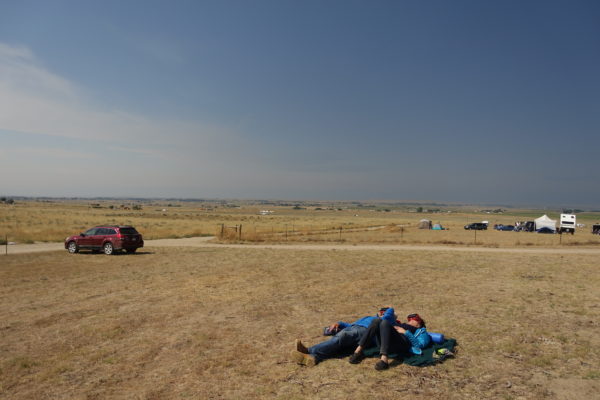
Us watching the sky, Gerry Monzon photo.
A cry went up throughout the grounds: “It’s happening!” Now we all were watching much more often as the moon continued its march toward the opposite edge of the sun. Verification that we were in a perfect place to see this perhaps once-in-a-lifetime event came with the observation that the uncovered area of the sun was nearly perfectly symmetrical as the eclipse progressed.
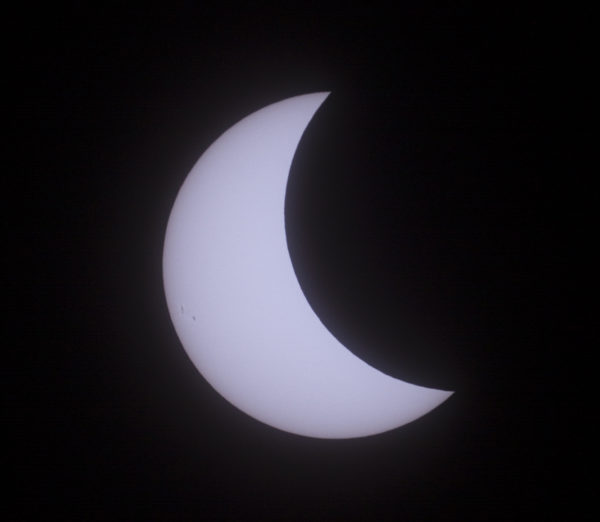
The attached image is of a partial solar eclipse leading up to totality. The camera lens had a solar filter on it to protect it from the suns radiation. That is what is giving the blue tint. At the 8:00 position are two sunspots. Andrew Macica info and photo.
Now lying on the ground with our goggles held tight against our faces, we watched in amazement as totality approached and felt, as much as saw, the darkness coming on. Someone shouted to turn around and, glasses off, we saw the shadow coming on at somewhere around 2000 miles per hour!
Then it was dark.
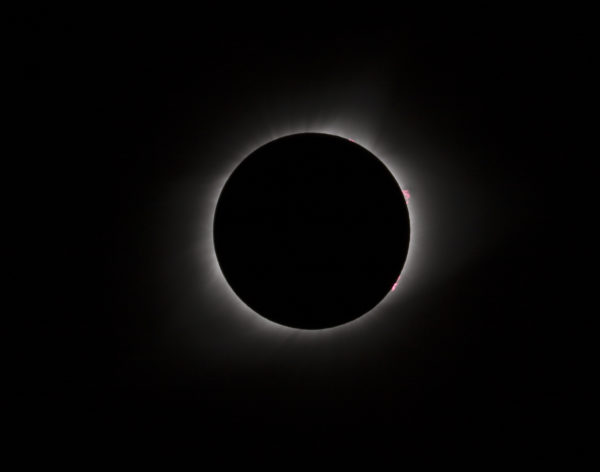
“This image focuses on the Sun’s inner atmoshere of Hydrogen, the chromosphere. It glows red. This tends to be of particular interest to scientists and seasoned eclipse watchers. If you look at the 1:00, 2:00 and 4:00 positions on the edge of the sun you see these fountains of solar material, red in color that shoot out and loop back on the sun. These fountains of solar material are called Prominences.” Andrew Macica info and photo.
When we looked through our dark goggles back at the place where the sun had been, we saw we were in totality and could witness this phenomenon with our naked eyes – a black moon with the corona of the sun completely surrounding it.
The map of the eclipse’s path through Wyoming said we under the centerline had totality for 2 minutes. I have no idea: it was hours or seconds. I was aware only of the majesty of this happening and of the silence around me.
Obviously my fellow watchers felt something very similar.
A cheer went up across the field: time to put the goggles back on; the sun was back in control.
We all watched as the moon cleared the lower edge of the sun, the crescent growing larger. We went back to watching through the glasses at longer intervals. Next I noticed that the grounds were clearing.
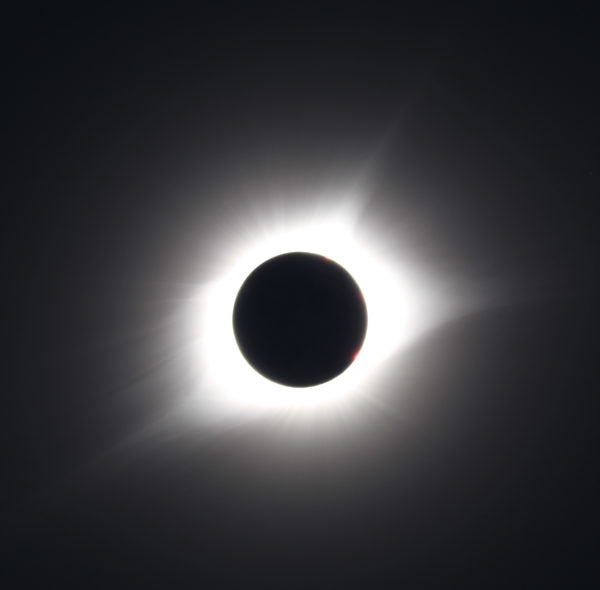
Total eclipse, image, Andy Macica.
Having witnessed this awesome – and yes, I know,”awesome” is probably the most overused word in the English language right now, but in this case, it is the only way to describe what we saw. It was truly awesome! – occasion, the crowd, filled to the top with this experience, began departing to wherever.
Twenty minutes or so after totality the campground was 2/3 empty. We stayed for a while talking to our new friends, but soon we too were back in the car, headed for Telluride, aware that we had been gifted with a memory forever seared into our minds – fortunately, because of good advice about eye protection, only our minds, not our eyes got a searing.
The drive to Riverton took about 10 hours; returning to Telluride, was a different, much longer story.
Traffic jams through parts of Wyoming and a navigation lapse resulting in a missed turn and a decision to sleep in Grand Junction, added up to nearly 24 hours. The eclipse from first contact through totality and back to full sun was about one hour.
Time well-spent?
Let’s put it this way: On April 8, 2024 I plan to be in Austin or San Antonio or maybe Cleveland for one more look at the mythical bear chomping on the sun.


Gerry Monzon
Posted at 08:09h, 24 Augustgreat job… So nice that we met that weekend. Made the event special.
Andy Macica
Posted at 09:01h, 24 AugustGreat article. We enjoyed meeting and being with on this adventure. I wish you all the very best.
Stephanie
Posted at 12:48h, 24 AugustWe LEFT Nashville 2 days before the eclipes, as we were visiting dear friends.
Came back to NYC for the partial eclipse seen from our cabin in the sky????????!
Yes, Awesome
And yes, again in 7 years!
That will make 3 times in my lifetime….lucky ducks!